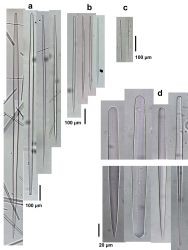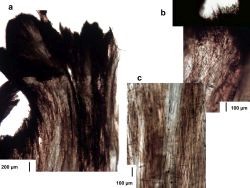brown
orange
massive
tough
United States
Aaptos sp.2-"brown tuberculate"
Description: Massive, rounded, flattened or elevated, up to 30-50 cm in diameter and 20-30 cm tall. External color dark brown, with the protuberances and oscules dark orange; interior yellowish. Surface strongly tuberculated, with tubercles of similar size, closely packed, blunt, low, and often divided. Oscules dispersed, membranous and slightly elevated, up to about 5 mm in diameter. Consistency toughly compressible. Skeleton as ascending, closely packed tracts of spicules, difficult to separate and discern in thick sections; at the surface there is a palisade of erect spicules of the smaller size category. Spicules are slightly curved anysostrongyloxeas (=fusiform styles) with the thickest portion in the apical half, resulting in very narrow heads and thicker tips, usually acute, but sometimes blunt, like style heads. Spicules occur in 2-3 size categories difficult to separate; smaller ones are more frequently true styles. In the material available, from Florida, the larger two categories are 487-1550 µm long by 5.5-47.5 µm wide, and the smaller category 250-450 µm long by 2.5-10 µm wide.
Notes: This species lives exposed in shallow lagoonal soft bottoms and under dock pilings. There is a great deal of confusion regarding how many species of Aaptos there are in the Greater Caribbean shallow waters, with names such A. pernucleata (Carter, 1870, also pictured here), A. duchassaingi (Topsent, 1889), A. bergmani de Laubenfels, 1953 and A. lithophaga (Wiedenmayer, 1977), plus species recently described from tropical NE Brazil by Moraes (2011), Aaptos glutinans, and by Carvalho, da Silva & Pinheiro (2013), A. hajdui and A. potiguarensis. We found three distinct species of Aaptos growing together in the Florida Bay side of Key Largo, all pictured here, one black, with large spicules (A. pernucleata), one dark brown and tuberculate, with smaller spicules (Aaptos sp.2), and the third light brown and smooth with slightly thicker spicules (Aaptos sp.3). Aaptos sp.2 is closest to Aaptos bergmani, which is smooth, golden brown to brown externally and rich yellow internally (de Laubenfels, 1950), and has comparatively smaller spicules than A. pernucleata (Rützler et al., 2014). There is need for comparisons of all western Atlantic Aaptos species’ types, but also of specimens from the same geographical area, owing to regional variation in spicule size.


